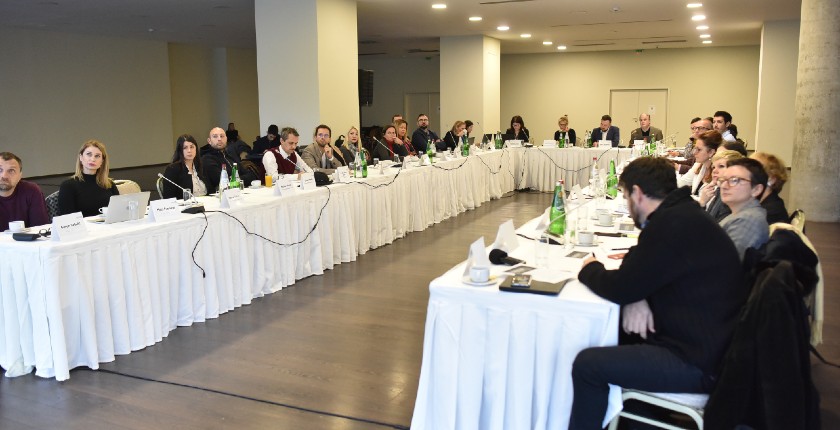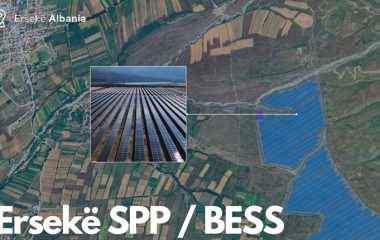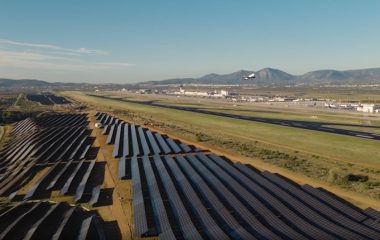
Photo: Balkan Green Energy News
Sites for building solar power plants should be selected in line with sustainable development principles, according to experts working on the project Smart-from-the start planning for sustainable development – Mapping solar potentials. At a roundtable with stakeholders, the experts presented a novel methodology they used to map suitable locations for Serbia’s first 1 GW of solar power capacity. They called for dialogue and cooperation on the project.
The Nature Conservancy, a global environmental non-profit organization, held a presentation of the methodology in Belgrade for state institutions, power utilities, investors and other stakeholders. The methodology was developed by local experts building on the know-how and experience of The Nature Conservancy, which conducts projects and research in more than 70 countries and territories around the world.
The methodology set out at the roundtable is still being determined and will be further improved by incorporating available data. The project’s ultimate goal is to create a publicly available map and tools that should help speed up the development of solar power plants with maximum economic and technical performance and minimal conflict with environmental and social criteria.
“Even though solar power plants produce “green” electricity, and we are inclined to support them unconditionally because of their key role in decarbonization and climate action, that support should by no means be unconditional, but rather in keeping with sustainable development principles,” said Branislava Jovičić, Editor-in-Chief of Balkan Green Energy News and stakeholder relations expert on the project.
Dialogue and cooperation are critical to successful mapping and sustainable solar development
As the methodology was being developed, the project team established communication with the institutions expected to support further work on the project and help improve the methodology and the map of sustainable sites.
The Nature Conservancy has signed a memorandum of understanding and cooperation with the Institute for Nature Conservation of Serbia, the Institute for the Protection of Cultural Monuments of Serbia, and the Land Institute, with plans to sign a similar document with the Ministry of Mining and Energy and to include Serbian power utility, transmission and distribution companies in the project.

The representatives of stakeholder who took part in the roundtable showed keen interest in the methodology and its results to date, and they voiced their willingness to take an active role in furthering the project and mapping Serbia’s solar potentials.
Recalling that the project is part of The Nature Conservancy’s regional initiative to support a sustainable renewables development, Igor Vejnović, Director of Strategic Initiatives of the South East Europe Program at The Nature Conservancy, said:
“The mapping project and preliminary maps are a good way to inform decision-making and speed up permitting on predefined “green” or “go-to” areas for the development and construction of solar power plants, but also to identify the possible course of the further development of solar energy in Serbia. Go-to areas are included in the measures applied by the European Union (EU) to tackle the energy crisis, and Serbia might consider introducing the concept even before such a standard becomes part of the EU accession process or an obligation under the Energy Community Treaty.
Identifying sustainable sites by avoiding conflicts
The underlying objective of the project is to accelerate the solar power development in Serbia, but in a sustainable way, support the country’s energy transition process and energy security, but also to help address the current energy crisis.
The chief experts on the project – Dr. Ilija Batas, a research associate at the Institute of Technical Sciences of the Serbian Academy of Sciences and Arts (SANU) and Dejan Doljak, a research associate at SANU’s Geographical Institute Jovan Cvijić – presented the findings of the project to date:
“To be designated as sustainable, a site must meet certain criteria. During the solar plants spatial planning, it is needed to evaluate the location as a resource, its limitations and values. The proposed site should not be located on agricultural land so as not to endanger food production,” said Doljak, adding that “the site must be aligned with biodiversity values as well as the visual identity of the area.”
“The proximity of the transmission or distribution system is also an important criterion,” said Batas, adding that the planning of solar power plants must involve superior performance with minimal environmental impact, at the optimal investment cost.

“Opinions and positions of local communities on such investments are among the most important considerations,” said Vejnović.
He added that the mapping process also needs to take into account national and local spatial plans as well as development plans of cities and municipalities. This, according to him, is the conclusion from three workshops with local adiministration officials and representatives of civil society organizations in Belgrade, Novi Sad, and Niš.
100 sites for Serbia’s first gigawatt of solar
The project team has identified a total of 100 sites suitable for building solar photovoltaic power plants of up to 10 MW, which could result in Serbia’s first gigawatt of environmentally and socially sustainable solar energy.
The capacity would be enough to cover about 5% of the country’s overall electricity consumption.

The methodology uses a geographic information system (GIS) and multiple-criteria analysis. The criteria used in the preparation of the project included the amount of solar radiation, terrain slope, the proximity of power transmission lines and roads, land cover, and the proximity of urban centers, railway lines, and ports. The methodology also includes criteria to assess the sensitivity of land in ecological, social, and cultural terms, such as the agricultural value of land or the visual quality of areas around tourist spots.
Tailings storage sites, abandoned mines, urban areas, and rooftops were not considered in the first stage of the project.
The authors noted that the methodology could be improved by expanding the scope of the analysis of the agro-economic value of land, as well as by incorporating more detailed data on low-voltage and medium-voltage networks.
Global prospects for Serbia’s solar mapping
Joe Kiesecker, a Lead Scientist at The Nature Conservancy, spoke about the global outlook for solar energy. He said that the global energy transition will be marked by the declining costs and greater availability of photovoltaic systems.
Kiesecker also talked about The Nature Conservancy’s experience, highlighting findings from the United States and India, where the organization is conducting an extensive research of sites for the installation of solar power plants and wind farms. He said that the existing global energy targets could be met by using land already converted for human activities, noting that the available land area for this purpose globally is 17 times larger than what is needed to achieve the goals of the Paris Agreement.

















Be the first one to comment on this article.